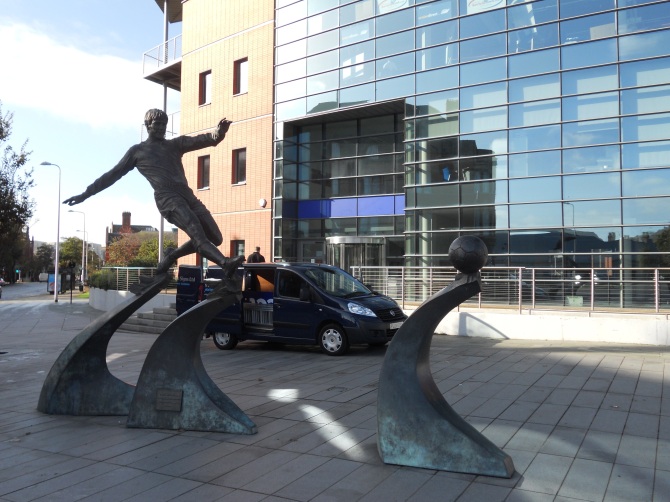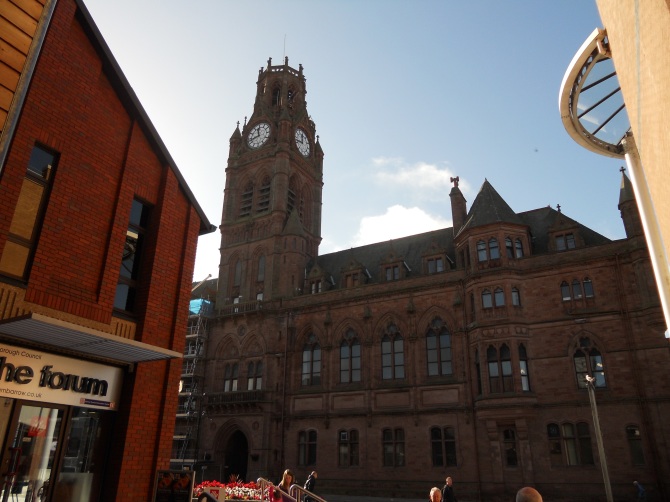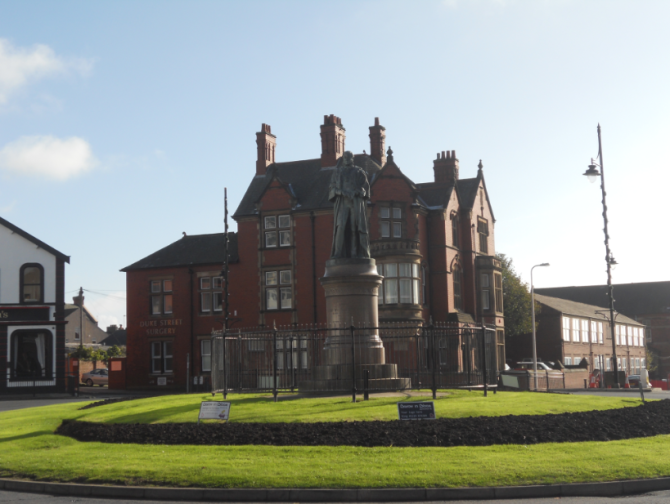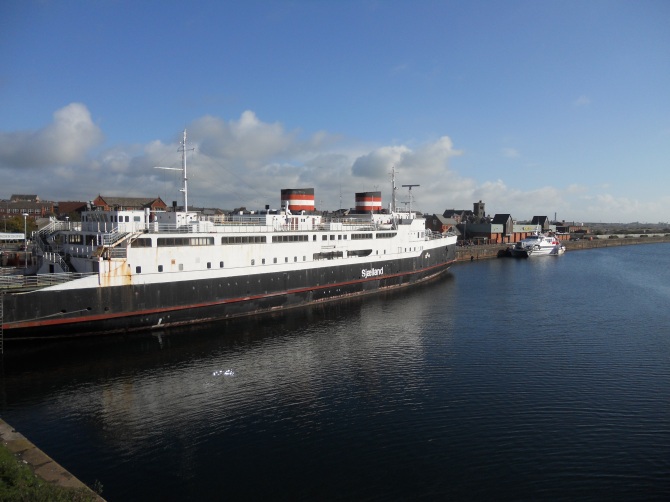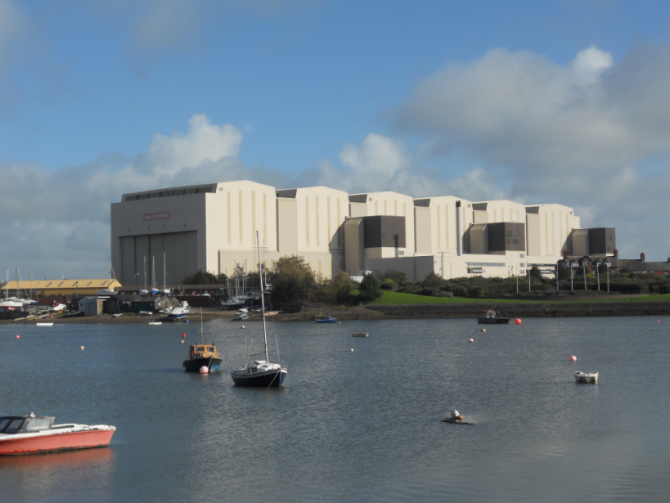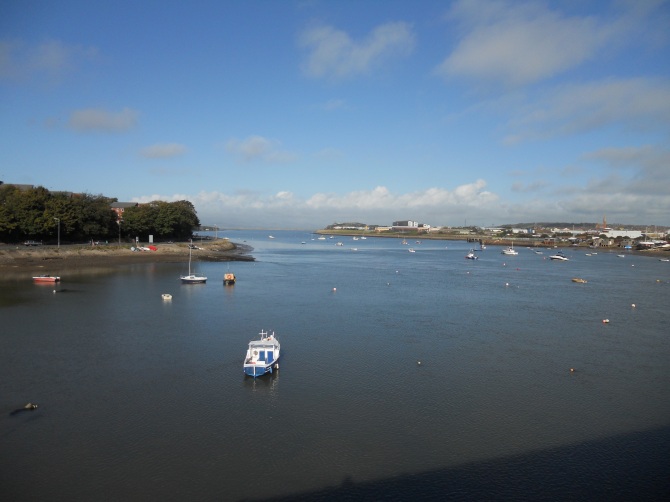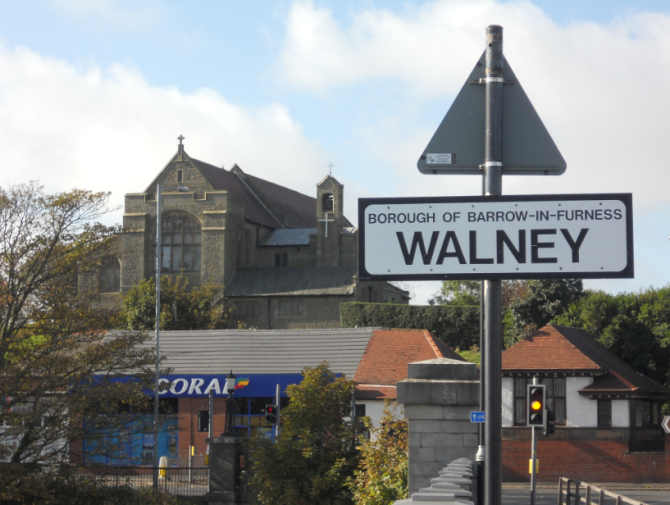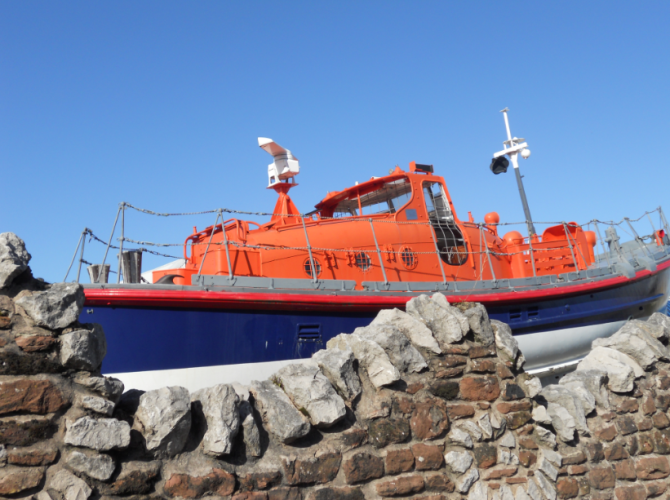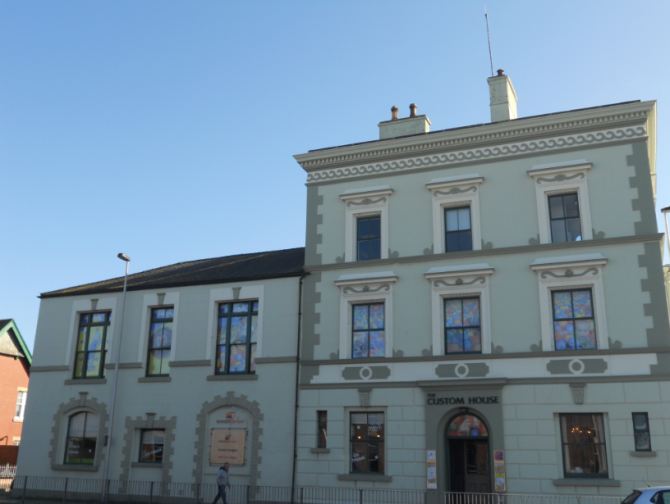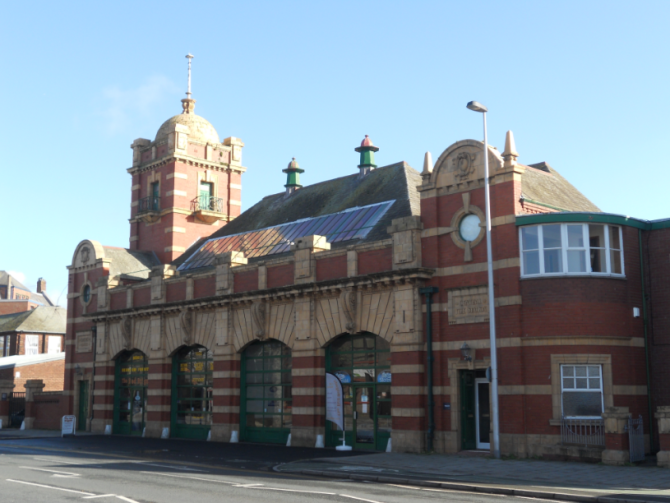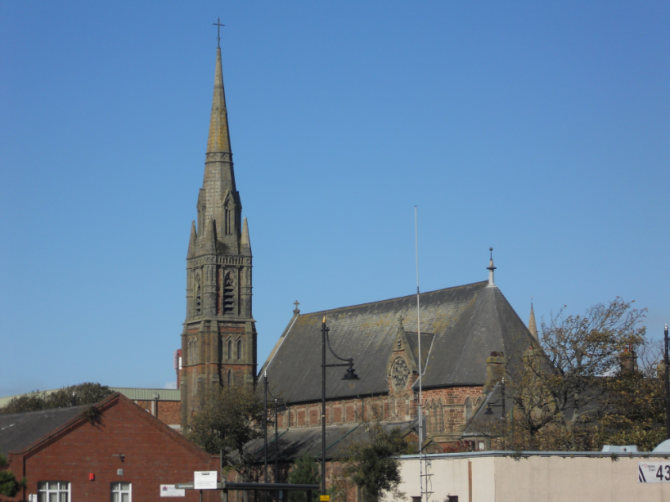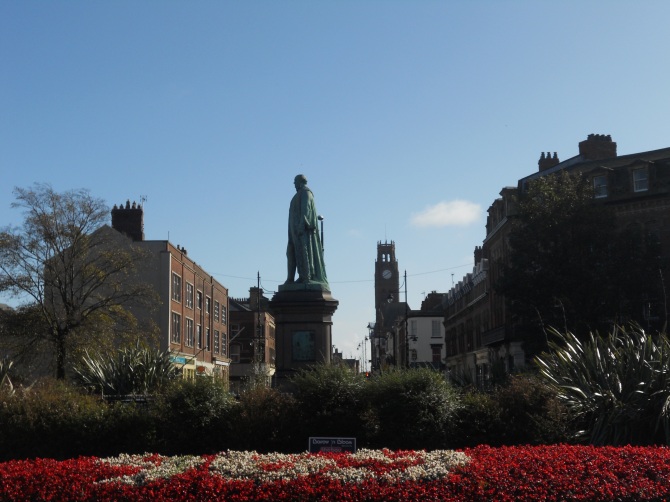Barrow-in-Furness (and Ulverston) was historically located in Lancashire, so is a good place to continue today’s Lancashire theme, in one of the most important industrial towns in the North, critical to Britain’s defence…
Barrow-in-Furness:
Status: Barrow-in-Furness District, Cumbria (Historically Lancashire), Town, England
Date: 17/10/2013
Travel: Transpennine Express (Preston – Barrow-in-Furness), Northern Rail (Barrow-in-Furness – Ulverston), Transpennine Express (Ulverston – Preston)
Eating & Sleeping: Ferry Hotel Walney Island
Attractions: Barrow Town Hall, Walney Island, Furness Abbey, BAE Systems, Walney Bridge, Barrow Dock Museum etc
Our journey into Barrow began just over the road from the train station, where we found a Statue of a local Footballer named Emlyn Hughes (1947 – 2004), erected in 2008. Hughes went on to Captain both the English National team and Liverpool FC. He was made an OBE (Order of the British Empire) and was also inducted into the National Football Museums (Manchester, moved from Preston) Hall of Fame.
Behind the Statue is the “Emlyn Hughes House” a large office building which was also completed in 2008. It was designed by Bowker Sadler Architects, and today houses offices for various companies. It replaces the previous building on the site, an old Cinema.
We continued into the town centre, and one of the most striking buildings is the Town Hall, one of many fantastic Victorian and Edwardian Town Halls that can be found throughout the North in various towns and cities, including Manchester, Bolton, Chester, Bradford, Leeds and Liverpool. Designed by William Henry Lynn (1829 – 1915, Irish Architect, who also designed Chester Town Hall) the building opened in 1886, after 4 years of construction, despite one quite major set back… The Clock Tower was found to have cracks in it near the end of the building work, and had to be completely rebuilt.
The main body of the building is built out of Hawcoat Sandstone, with Westmorland Slate covering the roof. Behind the building is the central square which almost makes it look back to front, and contains a statue of Lord Frederick Cavendish (1836 – 1882, English Politician) who was sadly murdered in Dublin in 1882 just after he had arrived to take up his new post as Chief Secretary for Ireland (Ireland was at that time part of the United Kingdom).
Fredericks Statue is one of many in the town, and just up the road we found another, that of Henry Schneider (1817 – 1887, British Politician) who helped to create Barrow, which was embellished as a new town. Henry stands in the centre of a roundabout, and behind him is Number 4, Duke Street, which was first built as a house at the start of the 20th century. It is a typical Victorian/Edwardian Building built out of fine Red Brick, and today it houses both a Doctors and a Dentists surgery.
We started heading towards Walney Island, a long island which is joined to Barrow via a bridge, and on the way we passed through the towns industrial area.
Barrow is known for its ship building and there were many old boats around including a former Danish ferry called the Princess Selandia, that was moved here in 2004 for refurbishment and was then used as a nightclub until a fire in 2010 left her in her current condition. She is presently moored in the Devonshire Dock, the oldest of four docks that make up the Port of Barrow. The Devonshire was opened by Prime Minister William Gladstone (1809 – 1898) at the end of the 1860’s, and it was followed in the 1870’s by the 2nd Dock, the Buccleuch Dock.
Part of the Devonshire was later filled in, the former parts of it being occupied by the Devonshire Dock Hall, shown above, which is the largest building in Cumbria, and the 2nd largest indoor shipbuilding hall in Europe. It was built between 1982 and 1986 for BAE Systems, who use it to build the UK’s fleet of Defensive Nuclear Submarines, the most recent being the HMS Audacious, the fourth in the Nuclear Astute Class.
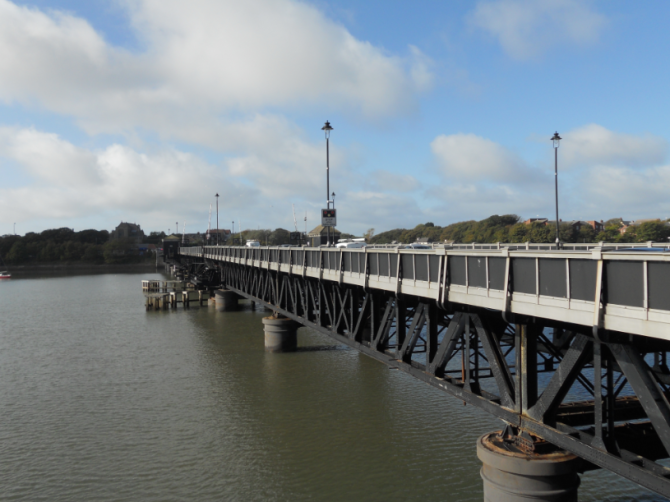
We soon reached Walney bridge, which bridges the gap between Barrow and Walney Island, which is considered an extension of the town, and separated from it by a short channel of water. Access to the island used to be limited to a ferry but in 1908, to commemorate the Diamond Jubilee of Queen Victoria, the chance was taken to build a bridge. It was renamed the Jubilee Bridge in 1935 by The Queen Mother, to honour the Silver Jubilee of King George V.
You get some great views from the Bridge, looking North towards Cumbria, or South to Lancashire and Blackpool. There is a large harbour for boats here and in the distance the hills of the Lake District National Park are visible, providing a stunning backdrop to the town.
On the far side of the bridge we spotted the Church of St Mary, a Grade II Listed Building dated back to 1908. Construction took another 20 years as the Vestry, Aisles and a West End were added to the building. Its position up on the hill gives it a commanding view out over Barrow, towards the Docks.
We stayed on the island for a while to take in the views, and enjoy some Fish & Chips at the Ferry Hotel, before heading back onto the mainland.
Our next stop was the Barrow Dock Museum, which has an old lifeboat called the Herbert Leigh (1951) outside. The Museum opened in its present location in 1994, the successor to the previous Museum from 1907. Located just across from the Devonshire Dock Hall, the Museum documents the rich industrial heritage of the town, which once had the worlds largest Steelworks.
The various exhibits cover many subjects, from the Steel Industry, Submarine building and the Barrow Blitz. Due to its importance as a large port and manufacturer, the town was heavily bombed during World War II, during April and May 1941. The Museum is free to enter, and you can find out more it’s official website here.
Continuing our exploration of the town, we started walking down Abbey Road and came across the Old Customs House, which, when it was opened in 1870, once contained the Customs Offices covering trade coming into the Port. It has fulfilled a variety of functions, including a spell as a Hotel and a Social Club, but today it is home to a restaurant along with the building to the left. Barrow is a great example of a Victorian Town, from the Customs House to the Town Hall, these gorgeous buildings line the towns streets.
The next building along was the old Central Fire Station, which missed out on being classed as Victorian by just a decade, and is instead a fine Edwardian building. The building is quite notable as it was one of the first new fire stations to be built around the new Fire Engines, and has a mosaic front that became common place around the country around this time.
There are quite a few Churches in Barrow, including the one shown above, another St Mary’s, in the Parish of “Our Lady of Furness” which can be found on Duke Street. It loomed in the distance, and often you can get a better view of buildings of this scale from a side street.
It does predate the Walney Church however, as it opened in 1867 and was the first Catholic Church to be built in the area. Designed by Edward Welby Pugin (1834 – 1875, architect who specialised in Churches and Cathedrals), the building is one of the finest Churches in Lancashire. Barrow is full of surprises and despite its reputation as an industrial town it has many fine gems that make it a great place to visit whatever your interests are.
We soon made our way back towards the train station, and on the way we passed yet another Statue. This one was of Sir James Ramsden (1822 – 1896) who helped the industrial side of the town by working for different companies, including the Furness Railway Company (1846 – 1922). Looking past the roundabout the Clock Tower of the Town Hall is also visible in the background. When we joined the roundabout we did reach Duke Street, and at either end are located the Town Hall and St Mary’s, although to reach the station we didn’t have to go down as far as the Church.
There are good rail connections to the town, with the railway heading up and round the Cumbrian coast up to Carlisle, as well as past Ulverston towards Lancaster with direct trains all the way to Manchester Airport.
As we entered and left the town, we passed Furness Abbey on the train, a large ruined Abbey right next to the tracks, dating back to 1123. It was a lovely day in Barrow, and being so close to the Lake District it was very scenic, with many impressive buildings. The train journey to Barrow also afforded amazing views as we passed over two river mouths on the way, those of the River Leven and the River Kent. We headed home, via the town of Ulverston, famous for its association with Laurel & Hardy…

